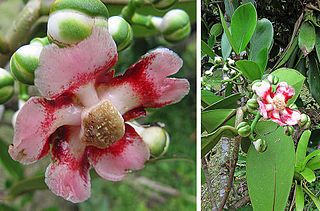
Bangs's mountain squirrel is a poorly known species of tree squirrel, that only lives in Costa Rica and Panama. It can be found in mountain rain forests at an altitude between 1,900 and 2,600 metres, and lives mainly in the tree tops, but sometimes on the forest floor as well. One of its habitats is at the summit of the Poás Volcano in Costa Rica, in a Clusia forest that is almost inaccessible to humans.

The brown-backed parrotlet also known as the black-backed parrotlet, the black-eared parrotlet, and Wied's parrotlet, is a small green parrot found in south-eastern Brazil from Bahia to southern São Paulo. It has a dark brown mantle and back, brown ear coverts, and red outer tail with back tips. They frequent humid forest from 500–1,000 m (1,600–3,300 ft), and are mostly found in small flocks of 3–20 birds.
Podocarpus hispaniolensis is a species of conifer in the family Podocarpaceae. It is endemic to the Dominican Republic.
Clusia carinata is a species of flowering plant in the family Clusiaceae. It is found only in Peru.
Clusia clarendonensis is a species of flowering plant in the family Clusiaceae. It is found only in Jamaica.

Clusia croatii is a species of flowering plant in the family Clusiaceae. It is found in Costa Rica and Panama, with one population in N Colombia. It is threatened by habitat loss.
Clusia cupulata is a species of flowering plant in the family Clusiaceae. It is found only in Panama. It is threatened by habitat loss.
Clusia longipetiolata is a species of flowering plant in the family Clusiaceae. It is found only in Panama. It is threatened by habitat loss.
Clusia minutiflora is a species of flowering plant in the family Clusiaceae. It is found only in Ecuador. Its natural habitat is subtropical or tropical moist montane forest.
Clusia plurivalvis is a species of flowering plant in the family Clusiaceae. It is found only in Ecuador. Its natural habitat is subtropical or tropical moist montane forest.
Clusia polystigma is a species of flowering plant in the family Clusiaceae. It is found only in Ecuador. Its natural habitat is subtropical or tropical moist lowland forest.
Clusia portlandiana is a species of flowering plant in the family Clusiaceae. It is found only in Jamaica. It is threatened by habitat loss.
Clusia pseudomangle is a species of flowering plant in the family Clusiaceae. It is found only in Peru.
Clusia skotaster is a species of flowering plant in the family Clusiaceae. It is found only in Ecuador. Its natural habitat is subtropical or tropical moist montane forest.
Clusia tarmensis is a species of flowering plant in the family Clusiaceae. It is found only in Peru.
Helicia amplifolia is a species of plant in the family Proteaceae. It is endemic to Papua New Guinea. It is threatened by habitat loss.
Helicia calocoma is a species of plant in the family Proteaceae. It is endemic to Papua New Guinea. It is threatened by habitat loss.
Helicia insularis is a species of plant in the family Proteaceae. It is endemic to Papua New Guinea. It is threatened by habitat loss.
Helicia neglecta is a species of plant in the family Proteaceae. It is endemic to Papua New Guinea. It is threatened by habitat loss.

Clusia rosea, the autograph tree, copey, cupey, balsam apple, pitch-apple, and Scotch attorney, is a tropical and sub-tropical plant species in the genus Clusia. The name Clusia major is sometimes misapplied to this species.




